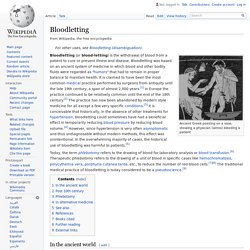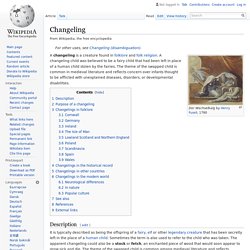

Bloodletting. Ancient Greek painting on a vase, showing a physician (iatros) bleeding a patient Bloodletting (or blood-letting) is the withdrawal of blood from a patient to cure or prevent illness and disease.

Bloodletting was based on an ancient system of medicine in which blood and other bodily fluids were regarded as "humors" that had to remain in proper balance to maintain health. In the ancient world[edit] A chart showing the parts of the body to be bled for different diseases, c.1310-1320 "Bleeding" a patient to health was modeled on the process of menstruation. The Talmud recommended a specific day of the week and days of the month for bloodletting, and similar rules, though less codified, can be found among Christian writings advising which saints' days were favourable for bloodletting. Post 10th century[edit] Ioannis Sculteti, Armamentium Chirugiae, 1693 — Diagrammed transfusion of sheep's blood Scarificator, showing depth adjustment bar Diagram of scarificator, showing depth adjustment.
A Brief History of Bloodletting - History in the Headlines. The ancient practice of bloodletting might offer cardiovascular benefits to obese people with metabolic syndrome, a new study published today in the journal BMC Medicine suggests.

As the medical community contemplates its revival, explore this long-abandoned procedure’s age-old history, from its early roots to its use on figures such as George Washington and Marie-Antoinette. Several thousand years ago, whether you were an Egyptian with migraines or a feverish Greek, chances are your doctor would try one first-line treatment before all others: bloodletting. He or she would open a vein with a lancet or sharpened piece of wood, causing blood to flow out and into a waiting receptacle. If you got lucky, leeches might perform the gruesome task in place of crude instruments. Considered one of medicine’s oldest practices, bloodletting is thought to have originated in ancient Egypt. America’s first president was less fortunate than France’s most infamous queen. The history of bloodletting. With a history spanning at least 3000 years, bloodletting has only recently—in the late 19th century—been discredited as a treatment for most ailments.

The practice of bloodletting began around 3000 years ago with the Egyptians, then continued with the Greeks and Romans, the Arabs and Asians, then spread through Europe during the Middle Ages and the Renaissance. It reached its peak in Europe in the 19th century but subsequently declined and today in Western medicine is used only for a few select conditions. Changeling. A changeling is a creature found in folklore and folk religion.

A changeling child was believed to be a fairy child that had been left in place of a human child stolen by the fairies. The theme of the swapped child is common in medieval literature and reflects concern over infants thought to be afflicted with unexplained diseases, disorders, or developmental disabilities. Description[edit] It is typically described as being the offspring of a fairy, elf or other legendary creature that has been secretly left in the place of a human child.
Sometimes the term is also used to refer to the child who was taken. D. The devil steals a baby and leaves a changeling behind, early 15th century, detail of "The legend of St. Purpose of a changeling[edit] One belief is that trolls thought that it was more respectable to be raised by humans, and that they wanted to give their own children a human upbringing. Other folklore[2] say that human milk is necessary for fairy children to survive.
Changeling. Changeling. History Changelings are humanoid creatures with discolored, slimy skin, hollow eyes, and a round mouth with many teeth.

They can appear human, but their true nature is revealed in their reflection. They feed on humans' synovial fluid.[1] Characteristics Powers and Abilities Have superior strength.[1] Have sharp teeth that allow them to feed on humans, and a lamprey-like mouth.[1] Can appear human.[1] Weaknesses Fire - Setting a changeling on fire will kill it.[1] Family - Killing a mother changeling will cause its children to die instantly.[1] Mirrors - A changeling's true form is revealed in a mirror.[1] The Colt (assumption)